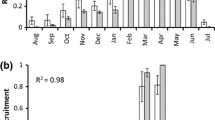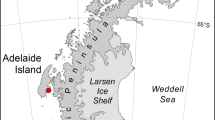Abstract
Understanding the demography and function of biotope-forming seaweed species is of great importance for the conservation of the target species itself, as well as its associated organisms. The brown seaweed Ascophyllum nodosum is fundamental for the functioning of coastal marine ecosystems in the North Atlantic. In this study, we use a data-based size-classified matrix model to investigate the temporal and spatial variability in demography, and the environment-specific stochastic sensitivity and elasticity, of two A. nodosum populations, one in western Sweden and one on the Isle of Man in the Irish Sea. A significant difference between the two populations was that the Swedish population had comparably low and more variable stochastic population growth rate (λs). This pattern was partly explained by the relatively high and varying mortality rates during extreme ice-years in Sweden, and by the lower survival of small individuals during all years. There were also fewer large individuals in Sweden due to lower transitions to the larger size-classes and higher probability of shrinkage. Sensitivities were analogous in the two populations, and showed a high selection pressure for increased individual growth. Elasticities were also similar, with the exception that survival of the smallest individuals (i.e., transition a1,1), had a higher elasticity on the Isle of Man. Overall, the stochastic growth rate (λs) was most sensitive to proportional changes in loop- (i.e., survival within size-class) and, to some extent, growth-transitions in both study areas. These results show that structurally and demographically diverging A. nodosum populations may be similarly sensitive to changes in vital rates. This, in turn, indicates a plastic life history of A. nodosum that may cope with large environmental variability. The results further suggest that environmental change affecting the survival or growth of the larger, reproductive A. nodosum individuals could have severe and regional effects on the abundance and biomass of this species, with potential negative effects on the biodiversity of the associated communities.






Similar content being viewed by others
References
Åberg P (1989) Distinguishing between genetic individuals in Ascophyllum nodosum populations on the Swedish west coast. Br Phycol J 24:183–190. doi:https://doi.org/10.1080/00071618900650171
Åberg P (1990) Measuring size and choosing category size for a transition matrix study of the seaweed Ascophyllum nodosum. Mar Ecol Prog Ser 63:281–287. doi:https://doi.org/10.3354/meps063281
Åberg P (1992a) A demographic study of two populations of the seaweed Ascophyllum nodosum. Ecology 73:1473–1487. doi:https://doi.org/10.2307/1940691
Åberg P (1992b) Size-based demography of the seaweed Ascophyllum nodosum in stochastic environments. Ecology 73:1488–1501. doi:https://doi.org/10.2307/1940692
Åberg P (1996) Patterns of reproductive effort in the brown alga Ascophyllum nodosum. Mar Ecol Prog Ser 138:199–207. doi:https://doi.org/10.3354/meps138199
Åberg P, Pavia H (1997) Temporal and multiple scale spatial variation in juvenile and adult abundance of the brown alga Ascophyllum nodosum. Mar Ecol Prog Ser 158:111–119. doi:https://doi.org/10.3354/meps158111
Åberg P, Svensson CJ, Caswell H, Pavia H (2009) Environment-specific elasticity and sensitivity analysis of the stochastic growth rate. Ecol Model (in press). doi:https://doi.org/10.1016/j.ecolmodel.2008.11.014
Austin GE, Rehfisch HA, Viles HA, Berry PM (2001) Impacts on coastal environments. In: Harrison PA, Berry PM, Dawson TE (eds) Climate change and nature conservation in Britain and Ireland: modelling natural resource responses to climate change (the MONARCH Project). UK Climate Impact Programme, Oxford, pp 177–228
Baardseth E (1970) Synopsis of biological data on knobbed wrack Ascophyllum nodosum (Linnaeus) Le Jolis. FAO Fish Synop 38:1–38
Benton TG, Grant A (1996) How to keep fit in the real world: elasticity analyses and selection pressures on life histories in a variable environment. Am Nat 147:115–139. doi:https://doi.org/10.1086/285843
Bergström L, Berger R, Kautsky L (2003) Negative effects of nutrient enrichment on the establishment of Fucus vesiculosus in the Baltic Sea. Eur J Phycol 38:41–46. doi:https://doi.org/10.1080/0967026031000096236
Brown JH, Lomolino MV (eds) (1998) Biogeography. Sinauer associates, Sunderland
Caswell H (1996) Second derivatives of population growth rate: calculation and applications. Ecology 77:870–879. doi:https://doi.org/10.2307/2265507
Caswell H (2001) Matrix population models. Sinauer Associates Incorporated, Sunderland
Caswell H (2005) Sensitivity analysis of the stochastic growth rate: three extensions. Aust NZ J Stat 47:75–85. doi:https://doi.org/10.1111/j.1467-842X.2005.00373.x
Caswell H, Kaye TN (2001) Stochastic demography and conservation of an endangered perennial plant (Lomatium bradshawii) in a dynamic fire regime. Adv Ecol Res 32:1–51. doi:https://doi.org/10.1016/S0065-2504(01)32010-X
Cervin G, Åberg P, Jenkins SR (2005) Small-scale disturbance in a stable canopy dominated community: implications for macroalgal recruitment and growth. Mar Ecol Prog Ser 305:31–40. doi:https://doi.org/10.3354/meps305031
Davies AJ, Johnson MP, Maggs CA (2007) Limpet grazing and loss of Ascophyllum nodosum canopies on decadal time scales. Mar Ecol Prog Ser 339:131–141. doi:https://doi.org/10.3354/meps339131
Davies AJ, Johnson MP, Maggs CA (2008) Subsidy by Ascophyllum nodosum increases growth rate and survivorship of Patella vulgata. Mar Ecol Prog Ser 366:43–48. doi:https://doi.org/10.3354/meps07453
de Kroon H, Plaisier A, van Groenendael J, Caswell H (1986) Elasticity: the relative contribution of demographic parameters to population growth rate. Ecology 67:1427–1431. doi:https://doi.org/10.2307/1938700
Dixon P, Friday N, Ang P, Heppel S, Kshatriya M (1996) Sensitivity analysis of structured-population models for management and conservation. In: Tuljapurkar S, Caswell H (eds) Structured-population models in marine, terrestrial, and freshwater systems. Chapman and Hall, New York, pp 471–514
Dudgeon S, Kubler JE, Wright WA, Vadas RL, Petritis PS (2001) Natural variability in zygote dispersal of Ascophyllum nodosum at small spatial scales. Funct Ecol 15:595–604. doi:https://doi.org/10.1046/j.0269-8463.2001.00559.x
Hawkins SJ, Hartnoll RG, Kain JM, Norton TA (1992) Plant-animal interactions on hard substrata in the north-east Atlantic. In: John DM, Hawkins SJ, Price JH (eds) Plant-animal interactions in the marine benthos, vol 46. Clarendon Press, Oxford, pp 1–32
Henry BE, Van Alstyne KL (2004) Effects of UV-radiation on growth and phlorotannins in Fucus gardneri (Phaeophyceae) juveniles and embryos. J Phycol 40:527–533. doi:https://doi.org/10.1111/j.1529-8817.2004.40502.x
Horvits CC, Tuljapurkar S, Pascarella JB (2005) Plant-animal interactions in random environments: Habitat-stage elasticity, seed predators, and hurricanes. Ecology 86:3312–3322. doi:https://doi.org/10.1890/04-1187
Jenkins SR, Hartnoll RG (2001) Food supply, grazing activity and growth rate in the limpet Patella vulgata L.: a comparison between exposed and sheltered shores. J Exp Mar Biol Ecol 258:123–139. doi:https://doi.org/10.1016/S0022-0981(01)00211-8
Jenkins SR, Hawkins SJ, Norton TA (1999) Direct and indirect effects of a macroalgal canopy and limpet grazing in structuring a sheltered inter-tidal community. Mar Ecol Prog Ser 188:81–92. doi:https://doi.org/10.3354/meps188081
Jenkins SR, Norton TA, Hawkins SJ (2004) Long term effects of Ascophyllum nodosum canopy removal on mid shore community structure. J Mar Biol Assoc UK 84:327–329. doi:https://doi.org/10.1017/S0025315404009221h
Jonsson PR, Granhag L, Moschella PS, Åberg P, Hawkins SJ, Thompson RC (2006) Interactions between wave action and grazing control the distribution of intertidal macroalgae. Ecology 87:1169–1178. doi:https://doi.org/10.1890/0012-9658(2006)87[1169:IBWAAG]2.0.CO;2
Keser M, Swenarton JT, Foertch JF (2005) Effects of thermal input and climate change on growth of Ascophyllum nodosum (Fucales, Phaeophyceae) in eastern Long Island Sound (USA). J Sea Res 54:211–220. doi:https://doi.org/10.1016/j.seares.2005.05.001
Kraberg AC, Norton TA (2007) Effect of epiphytism on reproductive and vegetative lateral formation in the brown, intertidal seaweed Ascophyllum nodosum (Phaeophyceae). Phycol Res 55:17–24. doi:https://doi.org/10.1111/j.1440-1835.2006.00441.x
Lilley SA, Schiel DR (2006) Community effects following the deletion of a habitat forming alga from rocky marine shores. Oecologia 148:672–681. doi:https://doi.org/10.1007/s00442-006-0411-6
Lorenzen S (2007) The limpet Patella vulgata L. at night in air: effective feeding on Ascophyllum nodsum monocultures and stranded seaweeds. J Molluscan Stud 73:267–274. doi:https://doi.org/10.1093/mollus/eym022
Murdoch WW, Evans FC, Peterson CH (1972) Diversity and pattern in plants and insects. Ecology 53:819–8129. doi:https://doi.org/10.2307/1934297
Pavia H, Brock E (2000) Extrinsic factors influencing phlorotannin production in the brown alga Ascophyllum nodosum. Mar Ecol Prog Ser 193:285–294. doi:https://doi.org/10.3354/meps193285
Pavia H, Toth GB (2000) Inducible chemical resistance to herbivory in the brown seaweed Ascophyllum nodosum. Ecology 81:3212–3225
Pavia H, Cervin G, Lindgren A, Åberg P (1997) The effect of UV-B radiation and herbivory on the production of phlorotannin in the brown seaweed Ascophyllum nodosum. Mar Ecol Prog Ser 157:139–146. doi:https://doi.org/10.3354/meps157139
Pavia H, Carr H, Åberg P (1999a) Feeding preferences and habitat selection of three crustacean mesoherbivores inhabiting the brown seaweed Ascophyllum nodosum and its epiphytes. J Exp Mar Biol Ecol 236:15–32. doi:https://doi.org/10.1016/S0022-0981(98)00191-9
Pavia H, Toth G, Åberg P (1999b) Trade-offs between growth and phlorotannin production in the brown seaweed Ascophyllum nodosum. J Ecol 87:761–771. doi:https://doi.org/10.1046/j.1365-2745.1999.00397.x
Pavia H, Toth GB, Åberg P (2002) Optimal defense theory: elasticity analysis as a tool to predict intraplant variation in defenses. Ecology 83:891–897
Roleda MY, Hanelt D, Wiencke C (2006) Growth and DNA damage in young Laminaria sporophytes exposed to ultraviolet radiation: implication for depth zonation of kelps on Helgoland (North Sea). Mar Biol (Berl) 148:1201–1211. doi:https://doi.org/10.1007/s00227-005-0169-0
Sagarin RD, Barry JP, Gilman SE, Baxter CH (1999) Climate-related change in an intertidal community over short and long time scales. Ecol Monogr 69:465–490
Schiel DR, Foster MS (2007) The population biology of large brown seaweeds: ecological consequences of multiphase life histories in dynamic coastal environments. Annu Rev Ecol Evol Syst 37:343–372. doi:https://doi.org/10.1146/annurev.ecolsys.37.091305.110251
Smith M, Caswell H, Mettler-Cherry P (2005) Stochastic flood and precipitation regimes and the population dynamics of a threatened floodplain plant. Ecol Appl 15:1036–1052. doi:https://doi.org/10.1890/04-0434
Thompson RC, Roberts MF, Norton TA, Hawkins SJ (2000) Feast or famine for intertidal grazing molluscs: a mis-match between seasonal variations in grazing intensity and the abundance of microbial resources. Hydrobiologia 440:357–367. doi:https://doi.org/10.1023/A:1004116505004
Toth GB, Karlsson M, Pavia H (2007) Mesoherbivores reduce net growth and induce chemical resistance in natural seaweed populations. Oecologia 152:245–255. doi:https://doi.org/10.1007/s00442-006-0643-5
Tuljapurkar SD (1990) Population dynamics in variable environments. Springer, New York
Tuljapurkar S, Horvitz CC, Pascarella JBT (2003) The many growth rates and elasticities of populations in random environments. Am Nat 162:489–502. doi:https://doi.org/10.1086/378648
Viejo R, Åberg P (2003) Temporal and spatial variation in the density of mobile epifauna and grazing damage on the seaweed Ascophyllum nodosum. Mar Biol (Berl) 142:1229–1241
Weaver AJ, Eby M, Wiebe EC, Bitz CM, Duffy PB, Ewen TL, Fanning AF, Holland MM, MacFadyen A, Matthews HD, Meissner KJ, Saenko O, Schmittner A, Wang HX, Yoshimori M (2001) The UVic system model: model description, climatology, and appplications to past, present and future climates. Atmos Ocean 39:361–428
Wikström SA, Steinarsdottir MB, Kautsky L, Pavia H (2006) Increased chemical resistance explains low herbivore colonization of introduced seaweed. Oecologia 148:593–601. doi:https://doi.org/10.1007/s00442-006-0407-2
Acknowledgments
We are grateful to the staff and students at Port Erin Marine Laboratory and Tjärnö Marine Biological Laboratory for their help and hospitality. This study was supported by the Swedish Natural Science Research Council through contract B-BU 9949-302, by the Swedish Research Council through contract 621-2007-5779, by Formas through contract 21.0/2004-0550, and by the Swedish Environmental Protection Agency through the project MARBIPP (Marine Biodiversity Patterns and Processes). MARICE (an interdisciplinary research platform at the Faculty of Sciences, University of Gothenburg), the Royal Swedish Academy of Science, through the foundation of Hierta-Retzius, and the foundations of Helge Ax:son Johnson, Knut and Alice Wallenberg, Wilhelm and Martina Lundgren and Kapten Carl Stenholm provided additional support.
Author information
Authors and Affiliations
Corresponding author
Additional information
Communicated by S. D. Connell.
Rights and permissions
About this article
Cite this article
Svensson, C.J., Pavia, H. & Åberg, P. Robustness in life history of the brown seaweed Ascophyllum nodosum (Fucales, Phaeophyceae) across large scales: effects of spatially and temporally induced variability on population growth. Mar Biol 156, 1139–1148 (2009). https://doi.org/10.1007/s00227-009-1156-7
Received:
Accepted:
Published:
Issue Date:
DOI: https://doi.org/10.1007/s00227-009-1156-7




